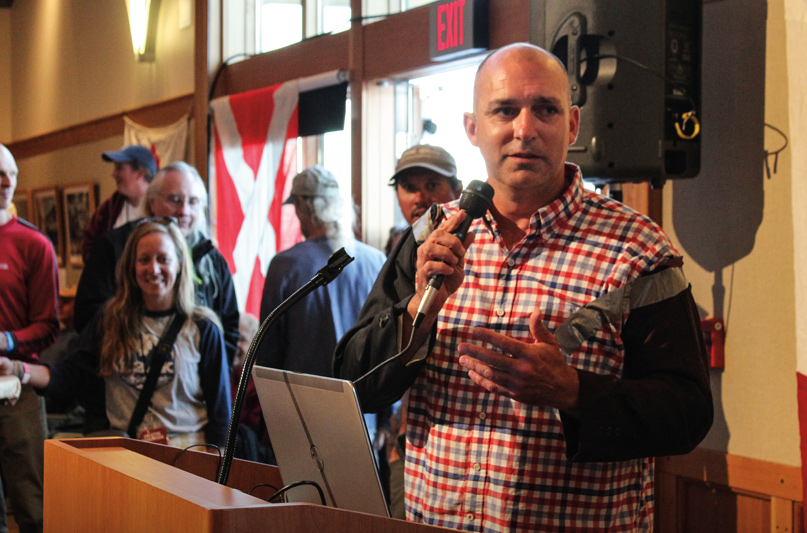
The Northwest Maritime Center in Port Townsend, Washington, was abuzz at the annual Race to Alaska (R2AK) Blazer Party on September 6. Always a jovial affair in which R2AK racers don thrift store blazers and partake in budget snacks like Goldfish crackers—imagine a subversive yacht club vibe—MCs Jake Beattie (Executive Director) and Daniel Evans (Race Boss) had more to share this year than the usual lineup of winners, sponsorship thank-yous, and delicious race stories. The Blazer Party’s big reveal was a major course change for the infamous engineless race.
“I think we should stop talking and play the video,” Beattie said to the crowd, pressing play on the annual promotional trailer. The scene unfolds; a map of the R2AK race course on the wall of a fictional (that we know of) top-secret underground R2AK headquarters. Almost with disdain, the waypoint of Seymour Narrows is plucked off the chart and thrown into the trash. Words appear: Simpler. Harder. Cue the racing montage to the Maori haka.
“R2AK’s relationship with Seymour Narrows is officially ‘open’,” declared Race Boss Daniel Evans to gasps and cheers. R2AK has run the same course for its five years of existence. The 750-mile route is chopped into two asymmetrical legs. Leg 1, the 40 miles from Port Townsend to Victoria, will remain unchanged in 2020. An unofficial weeding-out process, the 36-hour timeframe enforced on Leg 1 helps ensure that teams that shouldn’t proceed into the remote wilderness beyond can exit honorably where recovery is easy.
The 710-mile Leg 2 traditionally snakes up the inside of Vancouver Island with two mandatory waypoints: Seymour Narrows and Bella Bella. In the past, the race has largely been decided by who hits the proper tide window at Seymour Narrows. By removing the Seymour Narrows waypoint, R2AK 2020 opens an entire new outside option.
Debating which strategy will prevail—inside vs. outside—is bound to be the primary topic of discussion among the race’s fans. Although the outside route is longer mileage-wise and against the prevailing conditions (“uphill” as they say), dialed in bluewater race teams may bank on the gamble in exchange for the extreme speed they can achieve when unrestrained by the meddlesome tides, restrictive geography, and crippling low winds that can plague the inside route.
As someone who has completed the R2AK, my initial feelings about the move are of excitement. It’s a tough assignment for race organizers to balance what is beloved in a race program with new elements to keep it fresh and innovative. The idea that removing rules and regulations makes a race more exciting is very in line with the R2AK philosophy. Bottom line, those boat hipsters of Port Townsend still got it. Keep your eyes on them!
Interested? The starting gun goes off June 8, 2020 and applications for 2020 are currently open. Another new development for 2020 is the addition of a Frequent Floater card (do four races and the fifth is free!). Check out r2ak.com for more information, updates, and applications.